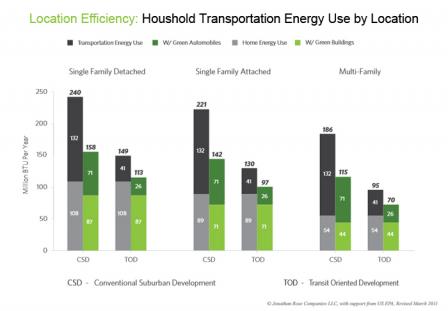Boiling It Down to BTUs
How and where we construct our communities has an enormous effect on our energy consumption. As of 2010, when this study was conducted, buildings and transportation together accounted for about 70 percent of energy use in the United States and about 62 percent of U.S. greenhouse gas emissions. Creating more energy-efficient communities and buildings would reduce our impact on climate change, reduce our reliance on foreign fuel and non-renewable energy, and save people money on household energy costs.1
People can do many things to reduce their energy use: install energy-efficient light bulbs, carpool or walk, or buy Energy Star appliances, among other things. But the way we plan and build our communities also has a significant role in creating a more environmentally and economically sustainable future. By understanding the relative share that housing type, location, and "green" (in this case, energy- or fuel-efficient) technology have in energy consumption, communities can begin to align their policies and public investments to support a more sustainable path forward.

EPA provided support to Jonathan Rose Companies to analyze the energy use associated with a range of development approaches. The study, Location Efficiency and Housing Type – Boiling it Down to BTUs, finds that housing type and location, along with energy-use features of homes and vehicles, all have an important role to play in achieving greater energy efficiency.
The study contrasts energy use in conventional, automobile-dependent locations with more location-efficient,2 transit-oriented locations; multifamily housing construction with single-family detached and attached houses; and conventional cars and homes with their energy-efficient counterparts (e.g., Energy Star homes and hybrid cars).
The annual household consumption of British Thermal Units (BTUs) of energy varies widely between the most and least energy-efficient homes. As Figure 2 illustrates, an energy-efficient, multifamily home using fuel-efficient vehicles and located in a transit-friendly site uses 70 million BTUs per year — less than 30 percent of the 240 million BTUs used by a single-family, detached home without energy-efficient features or cars in an automobile-dependent site.
In this comparison, the most effective way to reduce energy consumption is to locate homes of all types in areas where households could replace some automobile use with transit use, leading to reductions of 39 to 50 percent in household energy use. Still greater gains are possible when the location-efficient homes and their cars are energy efficient.

The paper illustrates the relative impact of different development approaches: locating homes where less energy-intensive transportation options are available; constructing homes that use less energy because they share walls, which reduces heat loss; and "greening" homes and cars through energy-efficient home construction techniques and fuel-efficient automobile technology. Its findings suggest that the most significant gains in household energy efficiency can be achieved when all of these efforts are combined.
These findings can help inform discussions among federal, state, and local policy-makers; local land use decision-makers; the construction industry; affordable housing advocates; and others on how to reduce the cost and increase the sustainability of new development. It highlights opportunities for communities to better foster this type of development by:
- Making appropriate public investments in transportation alternatives, including transit.
- Adopting zoning that encourages attached or multifamily housing, particularly near transit.
- Adopting building codes and incentives to encourage more energy-efficient construction.
Communities that adopt these strategies will realize environmental benefits – in the form of reduced per capita energy use – but also economic benefits, as lower energy costs mean more affordable housing and transportation and higher levels of disposable income to invest in the local community.
Resources
The Center for Transit-Oriented Development's Mixed-Income Transit-Oriented Development (MITOD) Action Guide Exit differs tools, strategies, and best practices for communities seeking to create more mixed-income, mixed-use, transit-oriented development.
Note: The paper was revised in March 2011 to account for updated transportation energy data that better represent the fuel mix of public transit systems.
1Energy statistics from the U.S. Energy Information Administration's Annual Energy Review 2009, August 2010. Greenhouse gas statistics from EPA's 2010 Inventory of U.S. Greenhouse Gas Emissions and Sinks, April 2010.
2The Center for Neighborhood Technology defines location efficiency in this way:"Compact neighborhoods with walkable streets, access to transit, and a wide variety of stores and services have high location efficiency. They require less time, money, and greenhouse gas emissions for residents to meet their everyday travel requirements." For more information about location efficiency and its connection to housing affordability, visit http://htaindex.cnt.org/ Exit.
You may need a PDF reader to view some of the files on this page. See EPA’s About PDF page to learn more.